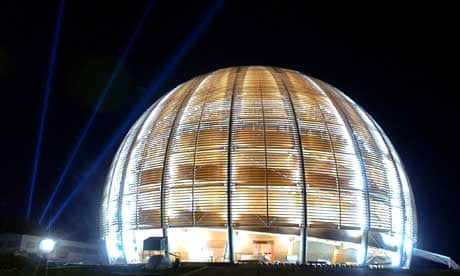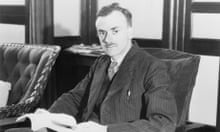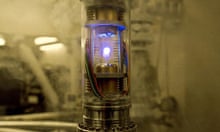In science fiction stories, antimatter pops up everywhere as a power source for spaceships or the active ingredient in diabolical bombs. In real life, though, this mysterious substance is elusive and scientists have never had much of it to play around with.
But that is to change: at the Cern particle collider in Geneva, physicists have created and trapped atoms of antihydrogen for more than a thousand seconds, it was announced late on Sunday. It might not sound like long, but it is enough time for experiments that could help answer some of the most fundamental questions in physics.
The same scientists, based at the Alpha collaboration in Cern, were the first to trap antihydrogen last year when they created and held on to 38 atoms of the stuff for 172 milliseconds in a strong magnetic field. In their latest work, published in this month's edition of Nature Physics, they trapped 309 antihydrogen atoms for varying amounts of time up to 1,000 seconds (just over 16 minutes).
Jeffrey Hangst of the University of Aarhus in Denmark, who led the experiments, said that the purpose of the study was to compare antimatter with atoms of normal matter. "We've studied what's going on with these atoms while they're in the trap, how they're moving, what energy or velocity they have. With 38, that was difficult, but with 300 it starts to look like something you can make averages out of. We're getting information about how they're behaving in the trap."
Antimatter was first postulated by the British physicist Paul Dirac in 1930 while working on a way to reconcile the ideas of quantum mechanics with Albert Einstein's theory of relativity. Particles of matter and antimatter are identical, except for an opposite electrical charge. An electron has a negative charge, whereas its antiparticle, the positron, has a positive charge, and both have an identical mass. Similarly, a proton and an antiproton are the same size and have the same mass, but have positive and negative charges respectively.
When a particle meets its antiparticle pair, the resulting annihilation turns their masses into pure energy, as determined by Albert Einstein's equation, E=mc2. If 1kg of antimatter came into contact with 1kg of matter, the resulting explosion would be the equivalent of 43 megatons of TNT – about 3,000 times more powerful than the bomb that exploded over Hiroshima.
Creating big explosions is not on the agenda for Hangst, however. For Hangst and his team, keeping the antihydrogen in place for more than a just few seconds will allow them to study the antimatter in its most natural state.
"If you think of an atom as a little planetary system with an electron orbiting the nucleus (or, in our case, the positron orbiting the antiproton), the ground state is the one where the electron or positron is closest to the nucleus," said Hangst. "We make our antihydrogen in excited states, the positron is at a larger distance and has more energy. That's not the state we want to study – we want to study the ground state. It takes some fraction of a second for these atoms to get to the ground state. You hold them for a thousand seconds, you can be quite sure they're in the state you want to study."
The question scientists want to answer is why antimatter seems to be missing from the universe. The laws of physics do not differentiate between matter and antimatter so, at the creation of the universe during the big bang, equal amounts of both should have been made. For every particle of matter in the universe, there should be a particle of antimatter. In practice, though, we do not see them.
At the start of the universe, cosmologists think, there was probably an infinitesimally small excess of matter particles over antimatter particles. When the particles came into contact and the inevitable annihilations occurred in the earliest seconds of time, the universe was left only with matter particles swimming with copious amounts of energy.
Why this asymmetry occurred at the start of the universe is unknown. There could be some as-yet-unknown differences between matter and antimatter particles – theoretically, there should be no differences, but the ideas have not been tested so far. By shining microwave and laser light on to the atoms and looking at the differences between antihydrogen and normal hydrogen, scientists will be able to interrogate whether the two atoms are as identical as physics theories imply, or whether the theories themselves need to be tweaked.



Comments (…)
Sign in or create your Guardian account to join the discussion